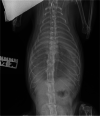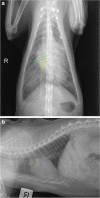Retrospective analysis of radiographic signs in feline pleural effusions to predict disease aetiology
- PMID: 35346189
- PMCID: PMC8959281
- DOI: 10.1186/s12917-022-03218-3
Retrospective analysis of radiographic signs in feline pleural effusions to predict disease aetiology
Abstract
Background: The objectives of the study were to determine the prevalence of underlying conditions causing pleural effusion in cats and to calculate the positive predictive values, negative predictive values, sensitivity and specificity of radiographic signs to predict aetiology of the pleural fluid.
Methods: Data from 148 cats with pleural effusion and diagnosed with known aetiologies were retrospectively analysed. Sixty one cats had thoracic radiographs evaluated by consensus through pre-defined radiographic signs by two radiologists blinded to the diagnoses.
Results: Congestive heart failure (53.4%) was the most common diagnosis, followed by neoplasia (20.3%), pyothorax (10.8%), idiopathic chylous effusion (5.4%), feline infectious peritonitis (1.4%) and "other" or cats with multiple diagnoses (total 8.8%). Cats with an enlarged cardiac silhouette had a high positive predictive value of congestive heart failure (90%). Mediastinal masses (100%)and pulmonary masses (100%) were highly predictive of neoplastic disease. Pulmonary nodules (50%) were poorly predictive of neoplastic disease. The remainder of the radiographic variables were not informative predictors of underlying disease.
Conclusions: In our sample of cats, congestive heart failure was the most common cause of pleural effusion. Radiographically enlarged cardiac silhouette and presence of a mediastinal mass may be useful predictors of aetiology, however there are limitations to the use of radiography alone as a diagnostic tool.
Keywords: Cardiomegaly; Congestive heart failure; Feline pleural effusion; Idiopathic chylothorax; Mediastinal mass; Pleural effusion; Positive and negative predictive values; Pyothorax; Radiographic parameters; Thorax radiography.
© 2022. The Author(s).
Conflict of interest statement
The authors declare that they have no competing interests.
Figures





References
-
- Suter P. Thoracic radiography: a text atlas of thoracic diseases of the dog and cat. Switzerland: Wettswil; 1984. Pleural abnormalities; pp. 648–764.
-
- Mandell D. Respiratory distress in cats. In: King LG. Respiratory disease in dogs and cats. Vol. 50, Saunders. W.B. Saunders; 2004. 12–17.
MeSH terms
LinkOut - more resources
Full Text Sources
Medical
Miscellaneous

